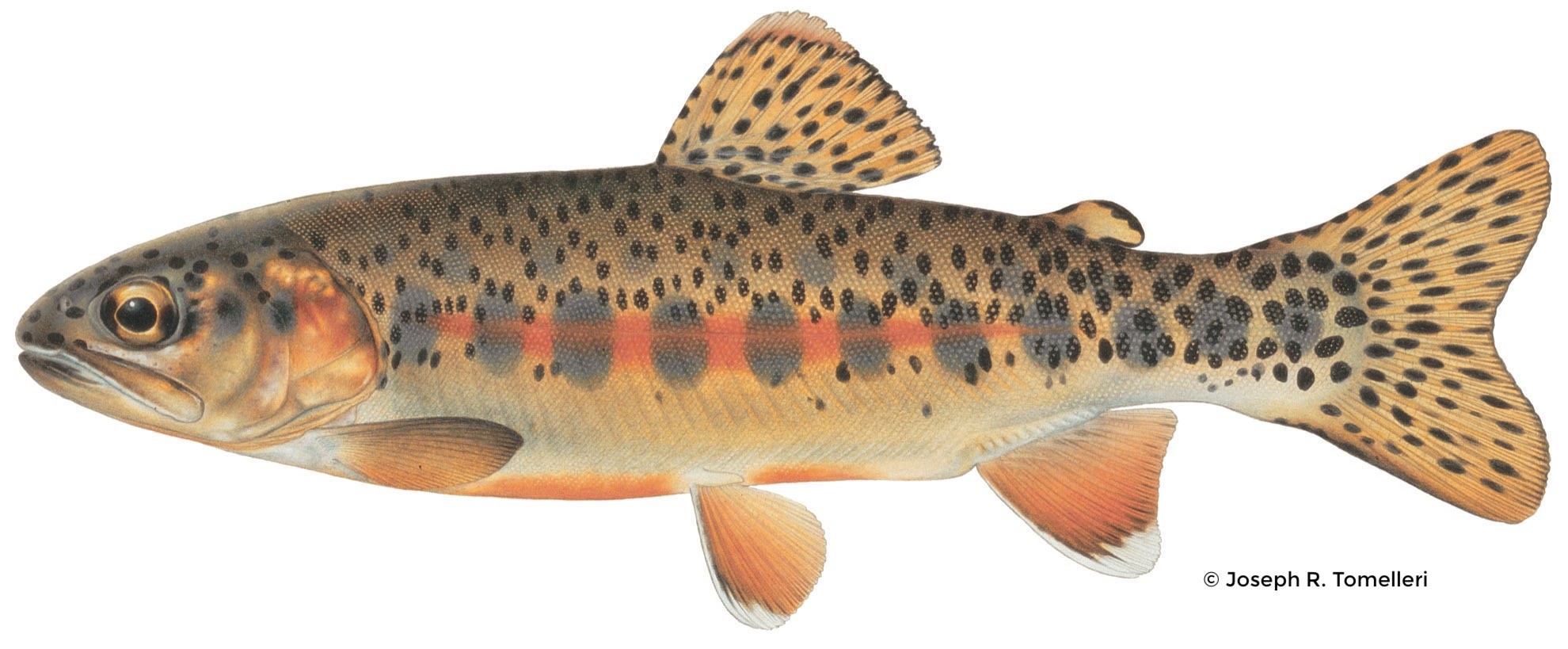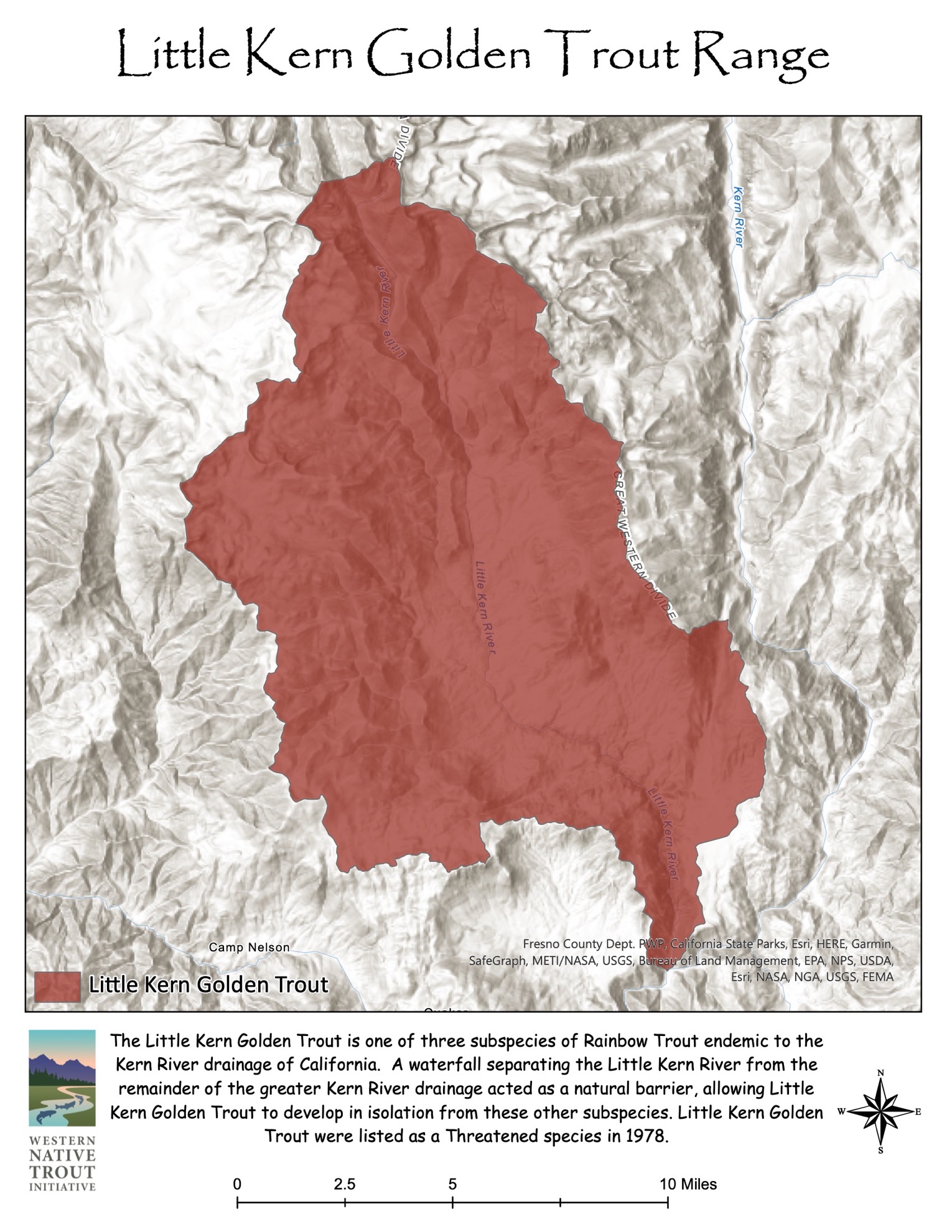
The Little Kern Golden Trout (Oncorhynchus mykiss whitei; hereafter LKGT) is one of three subspecies of Rainbow Trout endemic to the Kern River drainage (Tulare County, CA), occupying this area alongside the California Golden Trout (O. mykiss aguabonita) and the Kern River Rainbow Trout (O. mykiss gilberti; RBT). A waterfall separating the Little Kern River from the
remainder of the greater Kern River drainage acted as a natural barrier, allowing Little Kern Golden Trout to develop in isolation from these other subspecies. Little Kern Golden Trout are brightly colored fish, with olive green backs, red-orange cheeks and lateral bands, and gold-colored sides below their lateral lines. They are similar in appearance to California Golden Trout, though they typically have more spots on the head and below the lateral line, and their coloration often presents darker or more subdued; because of their relatively unique appearance they are highly sought-after by recreational anglers.
Extensive stocking of non-native trout in the Little Kern basin, subsequent hybridization with non-native Rainbow Trout strains, and competition with Eastern Brook Trout (Salvelinus fontinalis) and Brown Trout (Salmo trutta) contributed to precipitous declines in LKGT populations. These declines were further exacerbated by environmental degradation associated with logging and grazing, which reduced the amount of suitable stream habitat in their native range. In 1978 LKGT were listed as a Threatened species under the Endangered Species Act (ESA), citing concerns about their limited distribution, declining population abundance, the introgression of non-native genetics, and reduced habitat quality. They are also recognized as a Species of Special Concern by the State. LKGT are currently managed as a Heritage and Wild Trout species by the California Department of Fish and Wildlife (CDFW). CDFW prepared a management plan for the species in 1978 (Christenson 1978) and revised the plan in 1984 (Christenson 1984). This plan also serves as a de facto Federal recovery plan but is in need of updating by the recovery partners.
Summary of Management Actions: In the 1940’s CDFW biologists recognized the impact that non-native trout were having on LKGT populations and advocated for the immediate cessation of harmful stocking practices. Then in the 1970’s, CDFW biologists began an effort to eliminate non-native trout from the basin to allow pure populations of LKGT to spread across their historical range. The basin was divided into subunits based on the location of the six pure populations of LKGT identified from early genetics analyses. The idea was to pair newly recovered waters with the known pure LKGT populations to expand the distribution of the pure populations. Tributaries to the Little Kern River are generally steep and many natural barriers to upstream movement are present. However, numerous man-made barriers were also constructed to facilitate the recovery effort. Rotenone and antimycin were used to systematically eliminate non-native or introgressed trout populations, and LKGT from nearby streams were used to establish new LKGT populations in recovered streams. This process moved very slowly and carefully. Recovered streams were monitored to ensure chemical treatments were successful prior to stocking with LKGT. Beginning in 1984, some local sportsmen’s organizations expressed concern the recovery program was moving too slowly and insisted that CDFW accelerate their efforts. Beginning in 1985 CDFW brought LKGT from the basin into Kern River Planting Base (KRPB), near Kernville, to establish several broodstocks. A building was constructed to isolate the LKGT from the catchable-sized rainbow trout distributed to area waters from this facility. The five broodstock populations, each corresponding to a pure population identified at the time of their initial listing under the ESA, were marked with various fin clips for identification. LKGT were spawned and their offspring were planted in sections of stream newly cleared of non-native trout. The fish produced at the KRPB were never planted back into the sections of stream where the broodstock were collected to avoid negative impacts to known, pure populations of LKGT. By 1997, it was thought that the entire basin had been restored to LKGT through a program of chemical treatments, transplants, and supplementation with hatchery produced LKGT. However, in the late 1990’s CDFW biologists suspected, and then later confirmed, that some of the fish produced at the KRPB had been inadvertently hybridized with nonnative Rainbow Trout. As new genetic tools emerged, more robust methods became available to describe the genetic diversity of LKGT and the extent of introgressive hybridization with nonnative Rainbow Trout. These new methods were applied to samples opportunistically collected from 1995-2011, results of which were used to inform the 2014 Genetic Management Plan (GMP). In 2011, the Lion Fire burned more than 20,000 acres of the watershed; some of the most intensely burned habitat coincided with the occurrences of important recovery populations. Suddenly, the need to comprehensively survey LKGT populations became more urgent, and in 2012 a range-wide assessment of LKGT was initiated by CDFW and partners from the US Fish and Wildlife Service, US Forest Service, and National Park Service.
The range-wide assessment documented 37.2 km of occupied habitat in the mainstem of the Little Kern River and an additional 101.1 km of occupied stream habitat in its tributaries (total mileage of approximately 138 km).Genetic analyses revealed that of the three native trout subspecies in the larger Kern River watershed, LKGT have the lowest levels of genetic diversity. This suggests that these typically small, isolated populations are extremely vulnerable to deleterious effects of random genetic drift and stochastic catastrophic events (e.g.,fire or drought) and future intervention (i.e., genetic rescue) may be necessary to maintain populations with robust genetics health metrics. Results also indicated that some populations experienced bottlenecks, and as a result, potentially exhibit negative effects associated with inbreeding. Currently, genetic analyses are underway to explore the utility of identifying distinct LKGT management units within the Little Kern basin. This work could form the foundation of a genetic rescue plan to be implemented, if necessary, to bolster the genetic health of LKGT populations and avoid catastrophic losses that often befall small populations.
Although recognized as threatened under the Federal ESA, the listing package included a special 4(d) rule that allows the state to permit angling. Thus, wildlife managers in the state of California attempt to balance conservation priorities with demand from recreational anglers to provide fishing opportunities for these unique, colorful trout. There is a long history of anglers traveling to the Little Kern basin and enjoying fishing for LKGT as part of their backcountry experience. The California Heritage Trout Challenge, an angling recognition program established by CDFW, features opportunities for native trout angling and promotes angler and public awareness of native trout conservation issues. The Western Native Trout Challenge also includes the Little Kern Golden Trout in its western-wide trout Challenge. Many anglers come to the region.

Additional Resources
- READ about California Department of Fish and Wildlife’s efforts to conserve Little Kern Golden Trout. The Kern River Valley Historical Society announces the publication of its most recent book, “The Golden Trout Wilderness: The Forty Year Struggle to Preserve the Ancient Territory of the California Golden Trout.” Click here!
